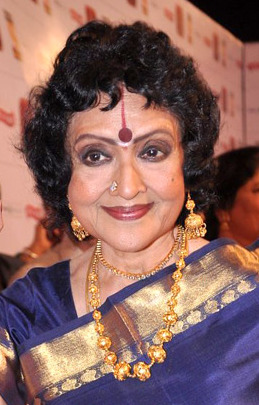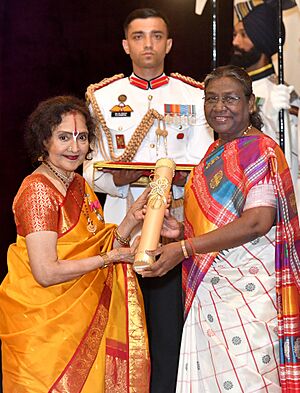Vyjayanthimala facts for kids
Quick facts for kids
Vyjayanthimala
|
|
|---|---|

Vyjayanthimala at Stardust Awards 2013
|
|
| Born |
Vyjayanthimala Raman
13 August 1933 Triplicane, Madras, Madras Presidency, British India
(present-day Thiruvallikeni, Chennai, Tamil Nadu, India) |
| Occupation | Actress, Indian classical dancer, Carnatic singer, politician |
| Years active | 1949–1970 |
|
Works
|
Full list |
| Spouse(s) |
Chamanlal Bali
(m. 1968; died 1986) |
| Children | Suchindra Bali |
| Parent(s) |
|
| Awards | Full list |
| Honours |
|
| Member of Parliament Lok Sabha | |
| In office 1984–1991 |
|
| Preceded by | Ramaswamy Venkataraman |
| Succeeded by | R. Sridharan |
| Constituency | Chennai South |
| Member of Parliament, Rajya Sabha | |
| In office 27 August 1993 – 26 August 1999 |
|
| Personal details | |
| Political party | Bharatiya Janata Party (1999–present) |
| Other political affiliations |
Indian National Congress (1984–1999) |
| Signature | |
Vyjayanthimala Bali (born 13 August 1933), known simply as Vyjayanthimala, is an Indian politician, dancer, and former actress. She is considered one of Hindi cinema's best actresses and dancers. She has won many awards, including five Filmfare Awards. She was the first female superstar of Indian Cinema. She started acting at 16 in the Tamil film Vaazhkai (1949). She then appeared in the Telugu film Jeevitham (1950). Her first Hindi cinema film was Bahar (1951). She became very famous with the romance film Nagin (1954).
She received great praise for her role in the historical drama Devdas (1955). This film is often seen as one of her best works. She won the Filmfare Award for Best Supporting Actress for Devdas. However, she did not accept it. She felt her role was a main one, just as important as her co-star's. She then starred in many successful films. These include the romance New Delhi (1956), the drama Naya Daur (1957), and the comedy Aasha (1957). Her roles in Sadhna (1958) and Madhumati (1958) earned her nominations for the Filmfare Award for Best Actress. She won for Sadhna.
In the 1960s, Vyjayanthimala played a village girl named Dhanno in the crime drama Gunga Jumna (1961). This role won her another Filmfare Award for Best Actress. She won the award again for the musical romantic drama Sangam (1964). She was also praised for her performance in the historical drama Amrapali (1966). Other notable films include Suraj (1966), Jewel Thief (1967), and Prince (1969).
In 1968, the Government of India gave her the Padma Shri. This is India's fourth-highest civilian honor. After starring in Ganwaar (1970), Vyjayanthimala stopped acting. She became well-known for her dancing, especially Bharata Natyam. This is a form of Indian classical dance. She later received the Sangeet Natak Akademi Award. This is the highest Indian award for performing artists. In 2024, she was given the Padma Vibhushan. This is India's second-highest civilian honor.
Contents
Early Life and Dance
Vyjayanthimala was born on 13 August 1933, in Triplicane, Madras. This area is now called Thiruvallikeni in Chennai, Tamil Nadu, India. She grew up in a Tamil family. Her mother, Vasundhara Devi, was a famous actress in Tamil Cinema in the 1940s. Vyjayanthimala was mostly raised by her grandmother.
When she was seven, Vyjayanthimala was chosen to perform a classical Indian dance for Pope Pius XII in 1940 at Vatican City. She went to Sacred Heart Higher Secondary School in Chennai. She learned Bharata Natyam from Guru Vazhuvoor Ramiah Pillai. She also learned Carnatic music from Manakkal Sivaraja Iyer. She had her first public dance performance, called an arangetram, at 13. After that, she started performing in Tamil Nadu.
Becoming a Film Star
In 1949, director M. V. Raman was looking for a new actress for his film Vazhkai. He saw Vyjayanthimala performing Bharata Natyam. Her grandmother was worried about her joining films because she was so young. But the director convinced them. Vyjayanthimala, at just 13, played a college girl in the film. The movie was a big hit.
A year later, the film was remade in Telugu as Jeevitham (1950). Vyjayanthimala acted in it again. She even dubbed her own voice in Telugu with help from her father. The success of Vazhkai led to it being remade in Hindi as Bahar in 1951. This was her first Hindi film. She learned Hindi to dub her own voice for this movie. Bahar was a big success.
In 1954, Vyjayanthimala starred in the romance Nagin. This film was a huge success and became the highest-grossing film of 1954. Her role as a Nagi tribe's chief was praised. Critics loved her beauty and graceful dancing. After Nagin, Vyjayanthimala became one of the top actresses in Hindi films. The song "Man Dole, Mera tan dole" with her dance became very famous.
Big Hits and Awards
In 1955, Bimal Roy cast her as Chandramukhi in Devdas. She starred opposite Dilip Kumar. People in the film industry were surprised by this choice at first. But Vyjayanthimala's performance was amazing. She won the Filmfare Award for Best Supporting Actress for this role. However, she refused the award. She believed her role was a main one, not a supporting one.
After Devdas, she acted in many successful films. In 1956, she starred in New Delhi. This romantic comedy was a big hit. She played a Tamil girl who falls in love with a Punjabi boy. Her performance and dances were highly praised.
In 1957, she starred in B. R. Chopra's Naya Daur with Dilip Kumar. She played a village girl named Rajni. The film was about "Man vs. machine" and was a huge success. It became the second highest-grossing film of 1957. Her acting was seen as natural and believable.
The year 1958 was very successful for her. She starred in Bimal Roy's Madhumati with Dilip Kumar. She played three roles in this film. The movie was a blockbuster and became the highest-grossing Hindi film of 1958. Her acting in all three roles was highly acclaimed. Madhumati was one of the first films to explore the idea of reincarnation.
In the same year, she also starred in Sadhna with Sunil Dutt. Her performance in Sadhna received great reviews. This film also did very well at the box office. For her roles in Madhumati and Sadhna, she was nominated for the Filmfare Award for Best Actress. She won the award for Sadhna.
In 1961, she starred in Dilip Kumar's film Gunga Jumna. She played Dhanno, a washerwoman. She learned the Bhojpuri language for this role. Her performance was widely praised. Critics were amazed by her ability to speak the dialect so well. The film was a huge blockbuster and the highest-grossing film of 1961. She won the Filmfare Award for Best Actress for Gunga Jumna. She also won her first Bengal Film Journalists' Association Awards for Best Actress.
In 1964, Vyjayanthimala starred in Raj Kapoor's first technicolor film, Sangam. This film was a big production and was shot in Europe. It was one of the longest Indian films at the time. Sangam became a huge success and is considered a classic love story. Vyjayanthimala's performance as Radha was highly praised. She won another Filmfare Award for Best Actress for this role.
Life After Acting
After some successful films, Vyjayanthimala starred in Amrapali (1966). This historical film was India's official entry for the Academy Award for Best Foreign Language Film. However, the film did not do well at the box office. This made Vyjayanthimala sad, and she decided to stop acting.
In 1967, she starred in Jewel Thief with Dev Anand. This crime thriller was a big hit. Her dance number "Hothon Pe Aisi Baat Main" became very popular. It is still considered one of the best dance numbers in Indian cinema.
Her last Hindi film was Ganwaar in 1970. After that, she retired from films. She was offered many roles by big directors and actors. But she refused them all because she did not want to return to acting. For example, she turned down the role of a mother in the famous 1975 film Deewaar. This role later went to Nirupa Roy.
A Career in Politics
Vyjayanthimala started her political career in 1984. She ran in the 1984 Tamil Nadu general election for the South Chennai area. She was a candidate for the Indian National Congress party. She won the election by a large number of votes. She then became a member of the Lok Sabha. This is the directly elected lower house of the Parliament of India.
In 1989, she ran for election again and won. Later, in 1993, she was chosen to be a member of the Rajya Sabha. This is the upper house of the Indian Parliament. She served for six years. In 1999, she left the Indian National Congress party. She said the party had lost its way after the death of Rajiv Gandhi. She then joined the Bharatiya Janata Party.
Her Amazing Legacy

Vyjayanthimala is seen as one of the greatest actresses in Indian cinema. She was one of the highest-paid actresses in the 1950s and 1960s. She was often listed as a top actress from 1954 to 1967. She was number one for six years (1958-1959, 1961-1964). Many people call her the "first female superstar" of Indian cinema. She was a star across different film industries in India. In 2007, Vyjayanthimala released her autobiography, called Bonding... A Memoir.
Images for kids
See also
 In Spanish: Vyjayanthimala para niños
In Spanish: Vyjayanthimala para niños
- List of Indian film actresses
- List of Indian women in dance
- List of actors who have played multiple roles in the same film


